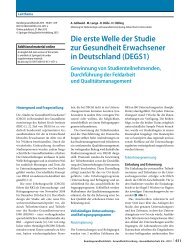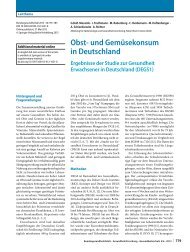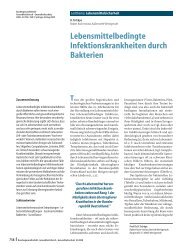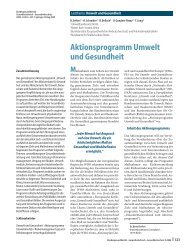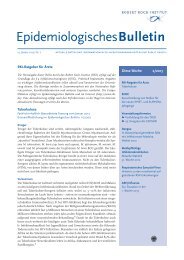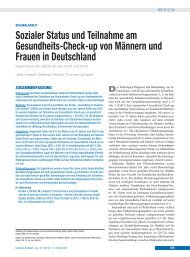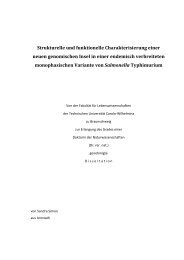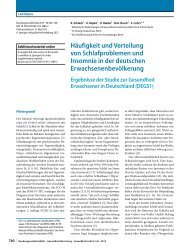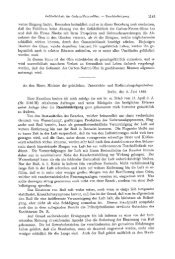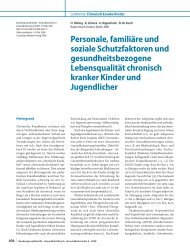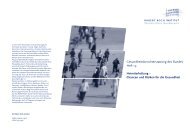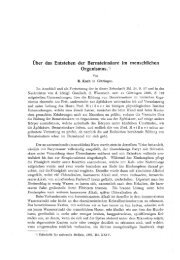Limo, Saft & Co - RKI
Limo, Saft & Co - RKI
Limo, Saft & Co - RKI
Sie wollen auch ein ePaper? Erhöhen Sie die Reichweite Ihrer Titel.
YUMPU macht aus Druck-PDFs automatisch weboptimierte ePaper, die Google liebt.
8<br />
GBE kompakt – 1/2013<br />
DifE - Deutsches Institut für Ernährungsforschung (2004) Stellungnahme<br />
des DIfE zum glykämischen Index.<br />
http://www.dife.de (Stand: 20.08.2013)<br />
Dubois L, Farmer A, Girard M et al. (2007) Regular sugar-sweetened<br />
beverage consumption between meals increases risk of overweight<br />
among preschool-aged children. Journal of the American Dietetic<br />
Association 107(6): 924–934; discussion 934–925<br />
Ebbeling CB, Feldman HA, Chomitz VR et al. (2012) A randomized<br />
trial of sugar-sweetened beverages and adolescent body weight. N<br />
Engl J Med 367(15): 1407–1416<br />
Fagherazzi G, Vilier A, Saes Sartorelli D et al. (2013) <strong>Co</strong>nsumption<br />
of artificially and sugar-sweetened beverages and incident type 2<br />
diabetes in the Etude Epidemiologique aupres des femmes de la<br />
Mutuelle Generale de l'Education Nationale-European Prospective<br />
Investigation into Cancer and Nutrition cohort. Am J Clin<br />
Nutrition 97(3): 517–523<br />
Flood JE, Roe LS, Rolls BJ (2006) The effect of increased beverage<br />
portion size on energy intake at a meal. J Am Dietetic Assoc 106(12):<br />
1984–1990<br />
Gardener H, Rundek T, Markert M et al. (2012) Diet soft drink consumption<br />
is associated with an increased risk of vascular events in<br />
the Northern Manhattan Study. J Gen Intern Med 27(9): 1120–1126<br />
Goletzke J, Herder C, Joslowski G et al. (2013) Habitually higher dietary<br />
glycemic index during puberty is prospectively related to increased<br />
risk markers of type 2 diabetes in younger adulthood. Diabetes care<br />
36(7): 1870–1876<br />
Hasselkvist A, Johansson A, Johansson AK (2010) Dental erosion and<br />
soft drink consumption in Swedish children and adolescents and the<br />
development of a simplified erosion partial recording system. Swed<br />
Dent J 34(4): 187–195<br />
Hauner H, Bechthold A, Boeing H et al. (2012) Evidence-based guideline<br />
of the German Nutrition Society: carbohydrate intake and<br />
prevention of nutrition-related diseases. Ann Nut Metab 60 Suppl<br />
1: 1–58<br />
HBSC-Team Deutschland (2011) Studie Health Behaviour in Schoolaged<br />
Children – Faktenblatt »Konsum von Softdrinks bei Kindern<br />
und Jugendlichen«. Bielefeld: WHO <strong>Co</strong>llaborating Centre for Child<br />
and Adolescent Health Promotion.<br />
Heidemann C, Scheidt-Nave C, Richter A et al. (2011) Dietary patterns<br />
are associated with cardiometabolic risk factors in a representative<br />
study population of German adults. Br J Nutr 106(8): 1253–1262<br />
Köhnke K (2011) Der Wasserhaushalt und die ernährungsphysiologische<br />
Bedeutung von Wasser und Getränken. Ernährungs-<br />
Umschau 2: 88–95<br />
Lampert T, Kurth B-M (2007) Sozialer Status und Gesundheit von<br />
Kindern und Jugendlichen. Ergebnisse des Kinder- und Jugendgesundheitssurveys<br />
(KiGGS). Deutsches Ärzteblatt 104(43):<br />
A2944–49<br />
Lampert T, Kroll LE, Müters S, Stolzenberg H (2013) Messung des sozioökonomischen<br />
Status in der Studie zur Gesundheit Erwachsener<br />
in Deutschland (DEGS1). Bundesgesundheitsbl – Gesundheitsforsch<br />
– Gesundheitsschutz 56:631–636<br />
Libuda L, Alexy U, Sichert-Hellert W, Stehle P & Kersting M (2008a)<br />
Pattern of beverage consumption and long-term association with<br />
body weight status in German adolescents - Results from the<br />
DONALD Study. Br J Nutr 99: 1370–1379<br />
Libuda L, Alexy U, Remer T et al. (2008b) Association between longterm<br />
consumption of soft drinks and variables of bone modeling<br />
and remodeling in a sample of healthy German children and adolescents.<br />
Am J Clin Nutr 88(6): 1670–1677<br />
Mensink GBM, Heseker H, Richter A et al. (2007) Ernährungsstudie<br />
als KiGGS-Modul (EsKiMo). Forschungsbericht. <strong>RKI</strong>, Universität<br />
Paderborn, Berlin, Paderborn<br />
http://www.bmelv.de (Stand: 20.08.2013)<br />
MRI – Max Rubner-Institut, Bundesforschungsinstitut für Ernährung<br />
und Lebensmittel (Hrsg) (2008) Nationale Verzehrsstudie II, Ergebnisbericht,<br />
Teil 2. Die bundesweite Befragung zur Ernährung von<br />
Jugendlichen und Erwachsenen. MRI, Karlsruhe<br />
http://www.wasesseich.de (Stand: 20.08.2013)<br />
Nettleton JA, Lutsey PL, Wang Y et al. (2009) Diet soda intake and risk<br />
of incident metabolic syndrome and type 2 diabetes in the Multi-Ethnic<br />
Study of Atherosclerosis (MESA). Diabetes Care 32(4): 688–694<br />
O'Neil CE, Nicklas TA, Rampersaud GC et al. (2012) 100 % orange<br />
juice consumption is associated with better diet quality, improved<br />
nutrient adequacy, decreased risk for obesity, and improved biomarkers<br />
of health in adults: National Health and Nutrition Examination<br />
Survey 2003-2006. Nutr J 11: 107<br />
Pan A, Hu FB (2011) Effects of carbohydrates on satiety: differences<br />
between liquid and solid food. Curr Opin Clin Nutr Metab Care<br />
14(4): 385–390<br />
Pudel V, Westenhöfer J (1998) Ernährungspsychologie. Eine Einführung.<br />
2. überarbeitete und erweiterte Auflage. Göttingen: Hofgrede.<br />
Richter A, Heidemann C, Schulze MB et al. (2012) Dietary patterns of<br />
adolescents in Germany - associations with nutrient intake and other<br />
health related lifestyle characteristics. BMC pediatrics 12:35<br />
Shang XW, Liu AL, Zhang Q et al. (2012) Report on childhood obesity<br />
in China (9): sugar-sweetened beverages consumption and obesity.<br />
Biomedical and environmental sciences: BES 25(2): 125–132<br />
Stahl A (2008) Lebensmittelverzehr und Nährstoffzufuhr bei Kindern<br />
der deutschlandweiten EsKiMo-Studie unter besonderer Berücksichtigung<br />
des Sozialstatus, Fakultät für Naturwissenschaften, Department<br />
Sport und Gesundheit, Universität Paderborn, Paderborn,<br />
S 265<br />
The InterAct consortium (2013) <strong>Co</strong>nsumption of sweet beverages and<br />
type 2 diabetes incidence in European adults: results from EPIC-<br />
InterAct. Diabetologia 56(7): 1520-1530<br />
Tucker KL, Morita K, Qiao N et al. (2006) <strong>Co</strong>las, but not other carbonated<br />
beverages, are associated with low bone mineral density in older<br />
women: The Framingham Osteoporosis Study. Am J clinical Nutr<br />
84(4): 936–942<br />
Tuttle C (1999) Childhood and Adolescence. Leach H (1999) Food Habits.<br />
In: Mann J, Truswell AS (Hrsg) Essentials of human nutrition .<br />
Oxford University Press, Oxford, New York, Tokyo, S 481–487<br />
Wyshak G (2000) Teenaged girls, carbonated beverage consumption,<br />
and bone fractures. Arch Pediatr Adolesc Med 154(6): 610–613



